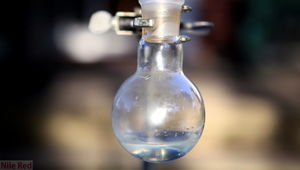Phosphorus tribromide
 Cloudy PBr3, freshly distilled
| |
| Names | |
|---|---|
| IUPAC name
Phosphorus tribromide
| |
| Other names
Phosphorous bromide
Phosphorus(III) bromide Tribromophosphine | |
| Properties | |
| PBr3 | |
| Molar mass | 270.69 g/mol |
| Appearance | Colorless fuming liquid |
| Odor | Pungent, acidic |
| Density | 2.852 g/cm3 (at 15 °C) |
| Melting point | −41.5 °C (−42.7 °F; 231.7 K) |
| Boiling point | 173.2 °C (343.8 °F; 446.3 K) |
| Hydrolyzes | |
| Solubility | Reacts with alcohols, carboxylic acids, esters Soluble in acetone, antimony(III) bromide, arsenic(III) chloride, bromoacetic acid, carbon disulfide, chloroform, liq. H2S, liq. SO2 |
| Thermochemistry | |
| Std enthalpy of
formation (ΔfH |
-185 kJ/mol |
| Hazards | |
| Safety data sheet | Sigma-Aldrich |
| Related compounds | |
| Related compounds
|
Phosphorus pentabromide Phosphoryl bromide |
| Except where otherwise noted, data are given for materials in their standard state (at 25 °C [77 °F], 100 kPa). | |
| Infobox references | |
Phosphorus tribromide is an inorganic colorless liquid with the formula PBr3. It is a dense liquid which fumes in open air and is used in chemistry to obtain alkyl bromides.
Contents
[hide]Properties
Chemical
Phosphorus tribromide reacts with water to form hydrobromic acid and phosphorus acid:
- PBr3 + 3 H2O → H3PO3 + 3 HBr
Physical
Phosphorus tribromide is colorless liquid, which fumes in air and immiscible with water, though it hydrolyzes slowly in it.
Availability
Phosphorus tribromide is sold by various suppliers, but due to its hazards it's almost impossible to obtain as private individual. It's best to make it yourself.
Preparation
Phosphorus tribromide can be made by reacting elemental bromine with red phosphorus. Make sure to add an excess of red P to prevent phosphorus pentabromide from forming.[1]
To limit the small fire that happens when you first add red P to the bromine s well as hydrolysis, a good idea is to purge the installation with an inert gas, such as nitrogen, carbon dioxide or argon. While the reaction can be done in neat, a solvent can also be used, such as carbon tetrachloride, carbon disulfide or benzene. This route is recommended if you're substituting red P with white P.
Decomposition of phosphorus pentabromide will give PBr3 and bromine. Adding small amounts of phosphorus to the mixture will greatly improve the yield.
Reaction of hydrobromic acid with phosphorus trichloride will give PBr3.[2]
Reaction of elemental bromine with phosphorus triiodide will also give phosphorus tribromide.[3]
A less known route involves the reaction of phosphorus vapors with mercury(II) bromide. The reaction gives phosphorus tribromide and mercury vapors, which are very toxic.[4]
Projects
- Make alkyl bromides
- α-bromination of carboxylic acids
Handling
Safety
Phosphorus tribromide fumes in air to release HBr fumes which are very corrosive and toxic. Wear proper protection when handling the compound.
Storage
PBr3 should be kept in teflon sealed glass bottles, in a dry place. Schlenk flasks are also a good storage container.
Disposal
Phosphorus tribromide should be neutralized with a base, such as calcium hydroxide suspension outside or in a well ventilated area. Since PBr3 is immiscible with water, it will sink to the bottom and not quickly hydrolyze. Lots of HBr fumes will be produced during neutralization. Sodium thiosulfate can also be used as neutralizing agent.
References
- Jump up ↑ https://www.youtube.com/watch?v=mYDYtsJ4NbQ
- Jump up ↑ Matignon, C.; Comptes Rendus Hebdomadaires des Seances de l'Academie des Sciences; vol. 130; (1900); p. 1393
- Jump up ↑ Gladstone, J. H.; Philosophical Magazine (1798-1977); vol. 35; (1849); p. 345 - 355
- Jump up ↑ Loewig, C.; Das Brom und seine chemischen Verhaeltnisse, Heidelberg 1829, p. 51
Relevant Sciencemadness threads
- Articles containing unverified chemical infoboxes
- Chemical compounds
- Inorganic compounds
- Phosphorus compounds
- Bromides
- Phosphorus halides
- Materials that react with water
- Materials unstable in basic solution
- Things that can kill you very quickly
- Things that should NOT be messed with except by professionals
- Choking agents
- Liquids